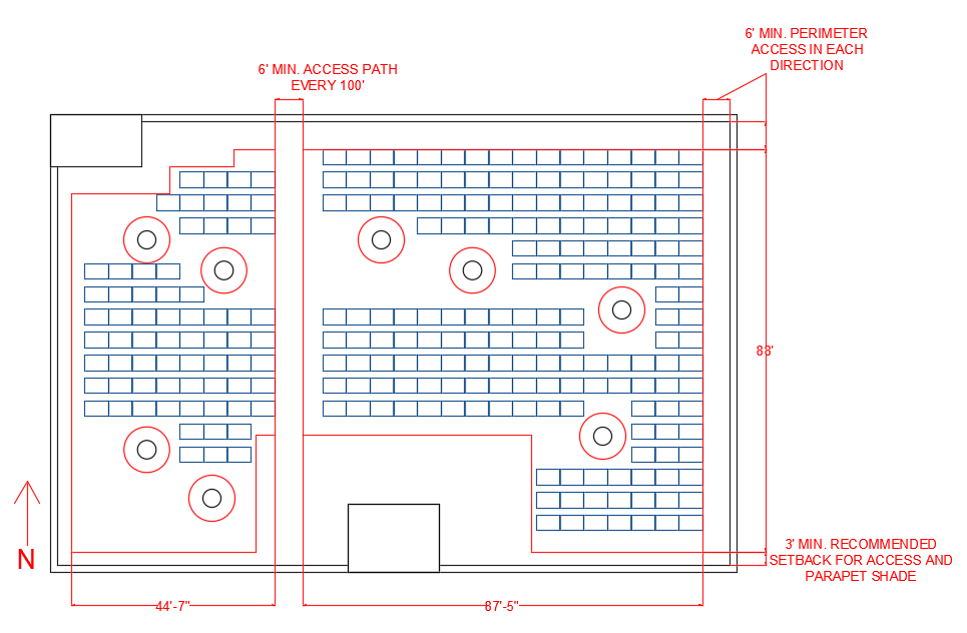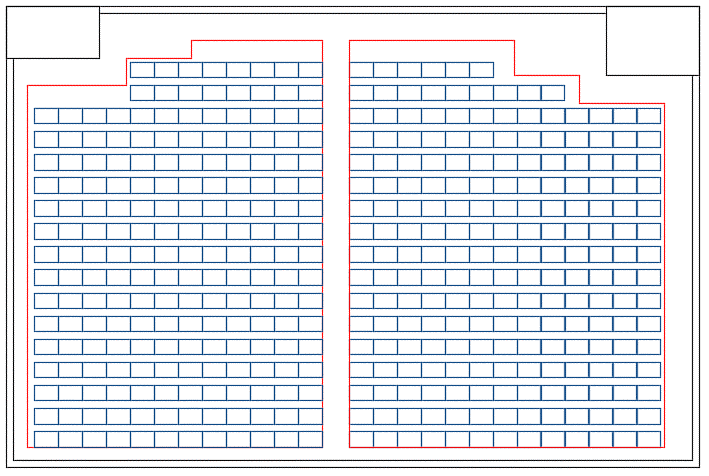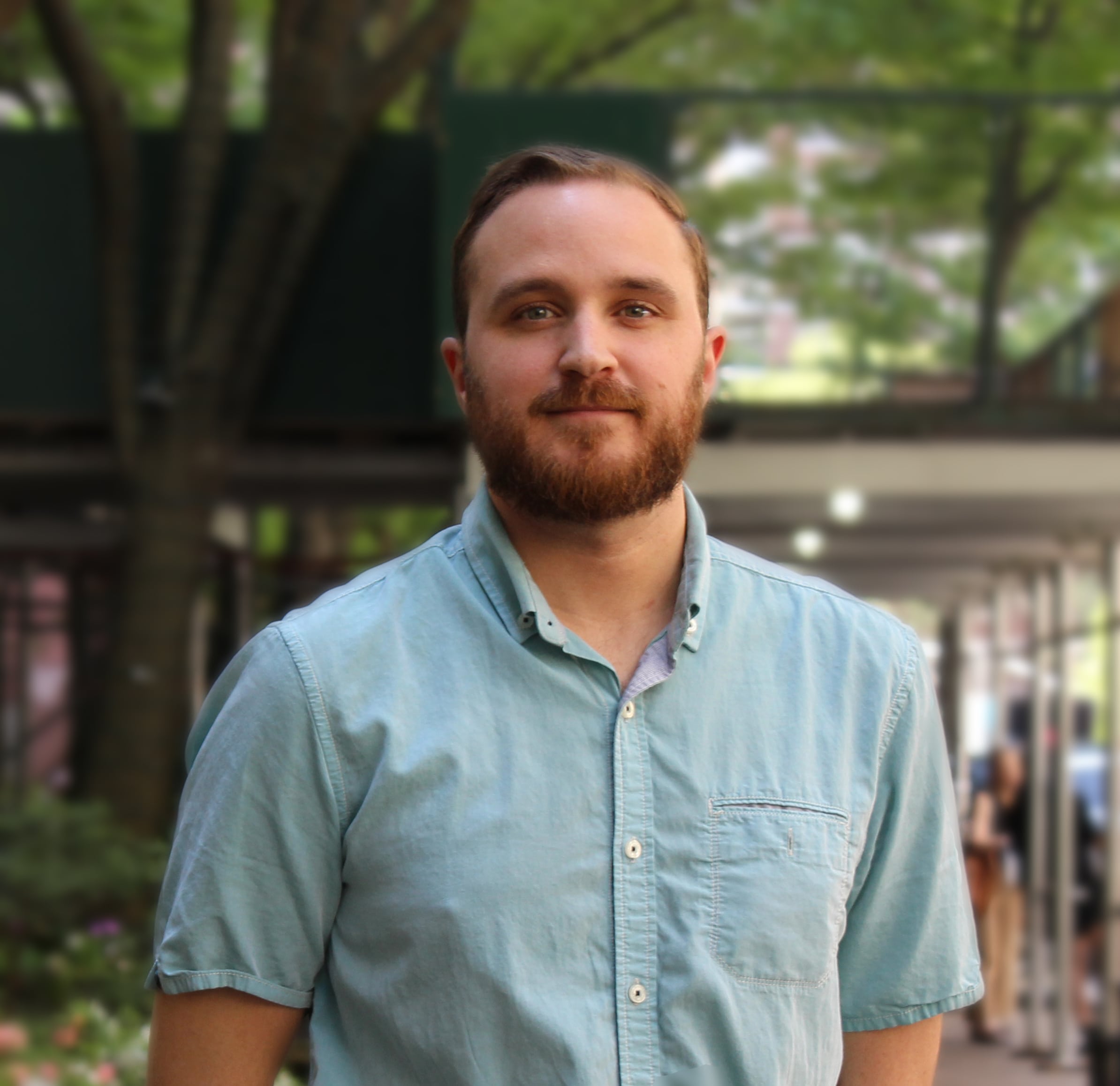- September 07, 2017
- 0 Comments
- In Existing Building Performance High-Performance Construction
- By Steven Winter Associates
As seen in:
Humans have been trying to harness the power of the sun for millennia. The advent and popularization of photovoltaics in the latter half of the twentieth century made doing so accessible to the masses. Today, solar arrays are commonly seen adorning the roofs of suburban homes and “big-box” retailers, as well as on other landscapes including expansive solar farms and capped landfills. Until recently, the common thread amongst these locations has been the employment of open space. Solar applications have historically been reserved for use in areas of low-to-moderate building density.
By the end of 2050, solar energy is projected to be the world’s largest source of electricity. While utility-scale solar will comprise the majority of this capacity, there will also be significant growth in the commercial and residential sectors – particularly in cities. Industry influencers are increasingly focused on creating opportunities for solar applications in high-density areas, where much of the demand lies.
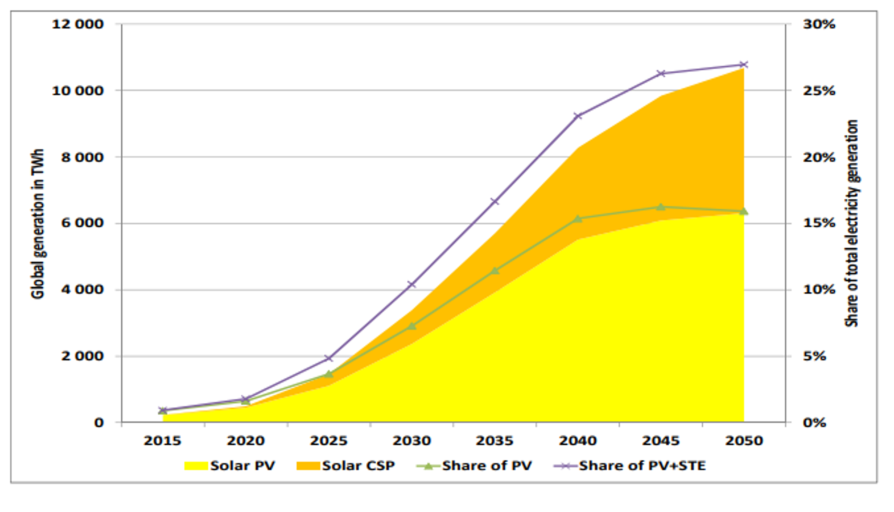 In their 2014 Technological Roadmaps for solar PV and solar thermal electricity (STE), the International Energy Agency (IEA) predicts Solar PV and STE to represent over 25% of global electricity generation by 2050.
In their 2014 Technological Roadmaps for solar PV and solar thermal electricity (STE), the International Energy Agency (IEA) predicts Solar PV and STE to represent over 25% of global electricity generation by 2050.
By the end of 2015, twenty U.S. cities accounted for six percent of the country’s solar photovoltaic (PV) capacity. This is particularly impressive, given that these cities combined account for merely 0.1% of U.S. land area. According to “Shining Cities 2016,” Environmental America’s report regarding the status of solar power in the United States, sixty-four of America’s cities have installed over 1,700 MW of cumulative solar PV capacity – almost as much as the entire country had installed by the end of 2010.
How are these cities doing it?
System costs across all sectors are rapidly decreasing due to an explosion in demand, pushing the industry further along its experience curve and leading to technological advances in modules, among other improvements. As costs continue to drop, solar power development becomes feasible in more challenging locations like high-density areas. Many cities have established green initiatives in order to increase the public visibility of renewable energy, pursue their own sustainable goals, and save money on operational costs. For example, in Las Vegas, 37 public buildings have reached a solar capacity of 6.2 MW. This includes fire stations, community centers, and parks, as well as a 3.3 MW generating station at the city’s wastewater treatment plant. Tampa, Raleigh, New York City, and Atlanta are also at the forefront of incorporating solar power into their government and public facilities.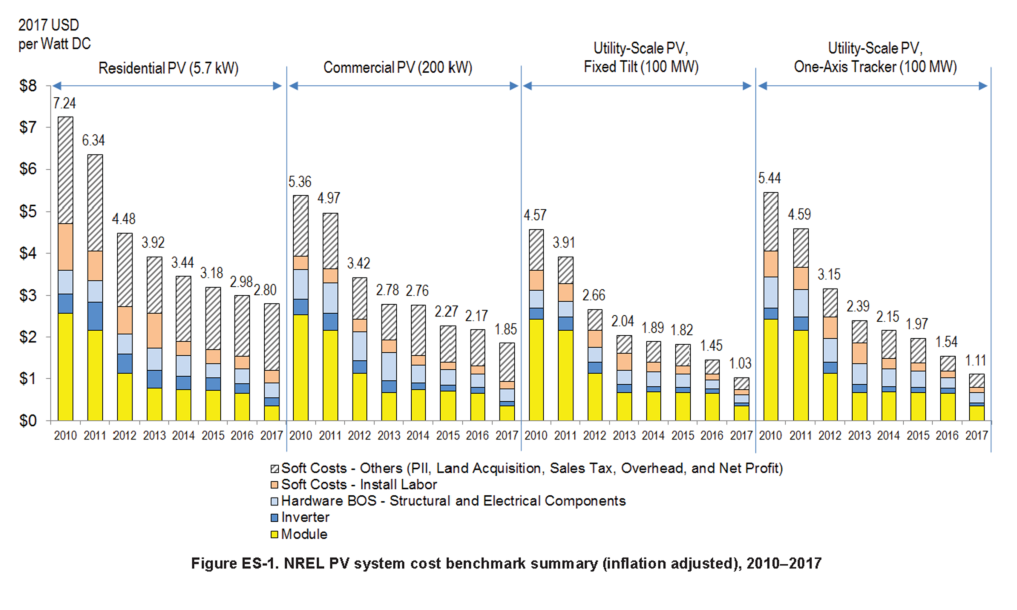 Benchmarking conducted by the National Renewable Energy Laboratory shows drastic reductions in solar installation cost across all sectors.
Benchmarking conducted by the National Renewable Energy Laboratory shows drastic reductions in solar installation cost across all sectors.
In addition to the reduced costs and increased supply of solar PV, demand is being bolstered by the availability of incentives. The Federal Investment Tax Credit (ITC) offers up to a 30 percent rebate for installation costs through 2019, and continues the offer at regularly diminishing levels through 2022. The ITC was renewed and the staged reductions were established at the end of 2016 with bipartisan support. However, the future of these credits is now being brought to question by the new House and Senate tax bills. For businesses, the federal government also allows MACRS accelerated depreciation of solar PV systems, with a special bonus for certain energy assets through 2019. Local and state programs across the country offer similar rebates, tax credits and deductions, or performance-based incentives that not only improve the affordability of solar installation, but also drastically shorten the payback period. The state of New York offers upfront cash rebates through NYSERDA, and Solar Renewable Energy Credit programs exist in eight states plus the District of Columbia.
While state and federal incentives are widely available now, they are either currently on the decline, or are planned to be phased out over the next five-to-ten years. Local policy and incentives will then become the key that emboldens building owners and residents to take part in continuing solar’s growth in urban environments. Solarize and other campaigns are locally organized community outreach efforts that leverage group purchasing power to encourage homes and businesses to go solar over an established period of time. Solarize NYC, one of the largest and most successful campaigns of its type, is aimed at energizing citizens to take personal responsibility in the city’s goal to reduce greenhouse gas emissions 80% by 2050.
Urban environments can offer opportunity for solar, but they also pose significant challenges. Tall buildings mean a much smaller ratio of available roof area to conditioned space; there are higher wind loads on the array; and the installation logistics become significantly more difficult. The close proximity of other tall buildings, plus roof space being taken up by bulkheads and large mechanical equipment, often leads to many sources of shade and a reduction of usable roof space. And, some buildings can have complicated ownership structures which lead to greater legal complexities, particularly when it comes to tax-based incentives.
Because of these challenges, the addition of solar PV usually offsets only the common area loads of a large building, not tenant loads. However, it can still be a financially attractive solution for developers and property managers. Thus, many newly constructed and renovated city buildings are opting for solar power even if most of the building’s electricity demand is still supplied by the grid. When combined with other distributed energy resources, such as energy storage, energy efficiency, and demand management, distributed solar can also help provide benefits to the distribution grid. New York State’s Renewing the Energy Vision initiative is seeking to establish a market for these benefits through its Value of Distributed Energy Resources program.
From a policy perspective, a city’s most immediate solution would be to update local building codes to require solar-ready roofs and incorporate other sustainable best practices. For instance, Cambridge, MA requires all new construction or existing building rehabilitation projects over 25,000 SF to meet at least LEED© Certified or LEED Silver standards – for which solar is a popular contributing factor. Washington, DC assigns a favorable weight to on-site renewable energy systems for compliance with its Green Area Ratio requirements. Additionally, the 2016 Energy Conservation Codes for both New York State and New York City include requirements for solar-ready roofs on new residential buildings. Similarly, states can adopt standard permitting and interconnection requirements, providing greater consistency for installers.
How are buildings designed for optimum PV performance?
A number of simple steps can also be taken while designing buildings in an urban environment to optimize for solar. Firstly, the roof should be designed to provide the greatest amount of roof space and least amount of shading for the solar array. Designing a building with unitized ventilation (i.e. in-line fans) eliminates the needed for many central exhaust fans on a rooftop. This not only frees up the specific space taken by the fans, but also the access pathways required for equipment maintenance. Any large equipment that must be placed on the roof and any other rooftop obstructions, namely stairwell and elevator bulkheads, should be placed as far to the north end of the roof as possible. Clear, unobstructed sun access to the south of the array is essential for systems in the northern hemisphere. When obstructions cannot be placed to the far north end, they should be placed strategically to allow for the largest, single area for an array. The simplest and least expensive racking system for a solar array is a ballasted system, which benefits immensely from a simple, rectangular array. These simple arrays allow the outer modules to effectively shield the inner modules from high wind loads, reducing the overall weight of the array as well as the cost of the system.
Typical roof layout for multifamily building, including necessary setbacks for fire access, mechanical equipment access, and shading from bulkheads. Fire access is based on FDNY guidelines.
Optimized roof layout for multifamily building, with bulkheads shifted to north side of roof and all mechanical equipment unitized or moved off of main roof.
Some simple structural and electrical engineering considerations should be included in the building design to optimize for solar. Including 5-10 psf of dead load in the structural calculations can go a long way in justifying the addition of a solar array in the future. Electrically, providing a dedicated breaker space in the main switchgear at the opposite end of the bus from the main breaker, a dedicated conduit run from the roof to the electrical room, and interior wall space in a rooftop mechanical room for mounting the inverters will all greatly simplify the design and installation, reduce the costs, and improve the aesthetics of the system.
As U.S. citizens and local governments take the reins in the country’s commitment to a clean energy future, solutions such as high-density solar are important industry advancements that provide more accessible and widespread opportunity for change. The urban environment provides a number of unique challenges to the development of solar, but a few key considerations in the design phase of new buildings as well as the adoption of intelligent local policy can help overcome these obstacles.
Written by:
Eric Wallace, Building Systems Engineer
Alex Mirabile, Marketing Coordinator

